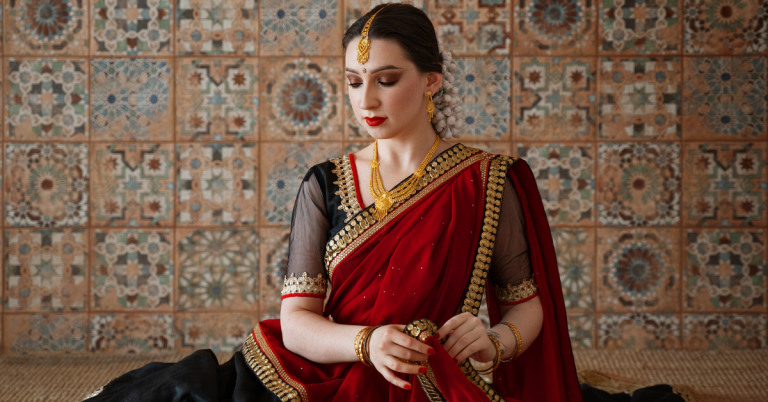Introduction
Do sarees wear have anything to do with the weather? The answer is a resounding yes! Sarees, a quintessential Indian attire, are not just a symbol of tradition and elegance but also an adaptable garment suitable for various weather conditions. Over centuries, sarees have evolved in design, fabric, and draping styles to align with the local climate. This article delves into the relationship between saree-wearing habits and weather patterns, providing insights into how and why this timeless attire remains relevant across seasons.
The Role of Fabrics in Weather-Appropriate Saree Choices
Light Fabrics for Summer
During hot and humid summers, the choice of saree fabric becomes crucial. Light and breathable fabrics like cotton and linen are commonly preferred. These materials wick moisture, allowing the body to stay cool and comfortable.
- Cotton Sarees: Ideal for regions with scorching summers, cotton sarees are lightweight and allow excellent airflow.
- Linen Sarees: With their natural texture and breathable quality, linen sarees are perfect for staying sweat-free.
Heavy Fabrics for Winters
In colder weather, heavier fabrics like silk and woolen blends are favored to provide warmth and insulation.
- Silk Sarees: Tightly woven silk sarees retain body heat, making them a popular choice for winter weddings and events.
- Woolen Sarees: These sarees are designed specifically for chilly climates, offering a cozy yet stylish solution.
Regional Variations: Do Sarees Wear Have Anything to Do with the Weather?
India’s diverse geography and weather patterns have significantly influenced saree-wearing traditions in different regions. Here are some examples:
Sarees in Coastal Regions
In coastal areas with high humidity, lightweight fabrics like cotton and chiffon dominate. Sarees are often designed in simple, breathable styles to combat the moisture-laden air.
Sarees in Northern Plains
The northern plains experience extreme temperatures, prompting varied saree choices. Cotton dominates summers, while wool blends and heavy silk are preferred in winter months.
Sarees in the Northeast
The hilly regions of the Northeast, with their cooler climates, favor handwoven, thicker sarees like those made of Eri or Muga silk.
Draping Styles and Weather Adaptation
Loose Drapes for Hot Climates
In hotter regions, sarees are draped more loosely to allow better air circulation. For instance:
- Bengali Draping Style: Characterized by pleats and a loosely hung pallu, it facilitates cooling.
Tighter Drapes for Cooler Climates
In colder areas, sarees are draped tightly to retain body heat. This style ensures minimal exposure to the cold.
Do Sarees Wear Have Anything to Do with the Weather in Urban Contexts?
Urban lifestyles have influenced saree usage significantly. While sarees remain a preferred attire for formal occasions, climate-conscious choices are evident.
Office Wear Sarees
For professionals, weather-appropriate sarees in cotton and blended fabrics dominate, balancing comfort and elegance.
Party Wear Sarees
For evening gatherings, weather often dictates the choice of fabric. Lightweight georgettes are ideal for summer parties, while velvet sarees are perfect for winter evenings.
Modern Innovations: Blending Style and Weather Adaptability
Sustainable Fabrics
Eco-friendly and weather-appropriate sarees made from organic cotton, bamboo fibers, and recycled silk are gaining popularity.
Weather-Resistant Sarees
Modern technology has introduced sarees with water-repellent and UV-protective coatings, catering to specific weather challenges.
Cultural Significance of Weather-Adapted Sarees
Beyond practicality, the weather-based evolution of sarees has deep cultural implications. Seasonal festivals often showcase weather-appropriate sarees as part of traditional attire. For example:
- Cotton sarees during Holi in spring to stay comfortable while enjoying the festivities.
- Heavy silk sarees during Diwali in autumn, reflecting opulence and the cooler climate.
Consequences of Ignoring Weather While Choosing Sarees
Choosing sarees without considering the weather can lead to discomfort and inefficiency. Wearing heavy silk in summer may result in excessive sweating, while opting for thin fabrics in winter can lead to chills.
Conclusion
Do sarees wear have anything to do with the weather? Absolutely! From fabric choices and draping styles to regional and seasonal preferences, sarees reflect an intricate balance between tradition, comfort, and practicality. By aligning saree choices with weather conditions, one can enjoy this elegant attire throughout the year. So, the next time you pick a saree, consider the climate to ensure comfort and style.
Call to Action
Explore sarees that align with your local weather and experience the seamless blend of tradition and functionality. Embrace the wisdom of saree culture to make every occasion comfortable and stylish!


